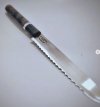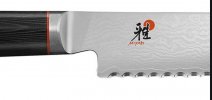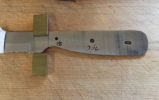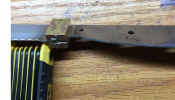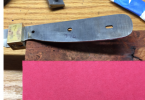Cushing H.
Gold Member
- Joined
- Jun 3, 2019
- Messages
- 2,714
Ok .... this is purely meant to be a fun thread, with all involved enjoying - hopefully it will play out that way. I have an "old" bread knife, bought in maybe something like 1998 or just a little before (I say that because my second son was born in 1998, and I walked into a knife store in a local mall (actually, "Southdale mall" - the first indoor mall in the world) and picked this baby up. It has been used continuously since then - slicing home made loaves, store-bought and home made french bread in the years since then. I have no earthly idea what alloy or hardness it is ... other than over the years it has shown no evidence of corrosion, so .... 410 maybe???. By the pictures below, it probably has a handle of maybe walnut (but not sure) .... but clearly had problems with adhesion ... since one side broke off, then a year or two after the other side lost is also. My guess is the rivets are Corbys (but can not be sure until I drill them out). At least once I have taken a file to the serrations. the knife still works ok (I used it tonight on some home made whole wheat french bread) .... but for several months I have been wondering... "what if......". New handle? Mosiac pin in the middle? re-grind the bevel? re-grind the serrations? I do not know what the current TBE is ... but to my finger-feel, it is not great (maybe 0.15 or thereabouts).
so ... here is an opportunity for you to chime in. Ive got to strip this handle off, but until then, I think the basic question is - re-grind to establish a lower TBE (however that is defined with a serrated edge....... Have at it....

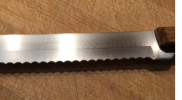
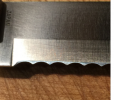
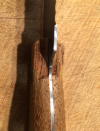
so ... here is an opportunity for you to chime in. Ive got to strip this handle off, but until then, I think the basic question is - re-grind to establish a lower TBE (however that is defined with a serrated edge....... Have at it....





